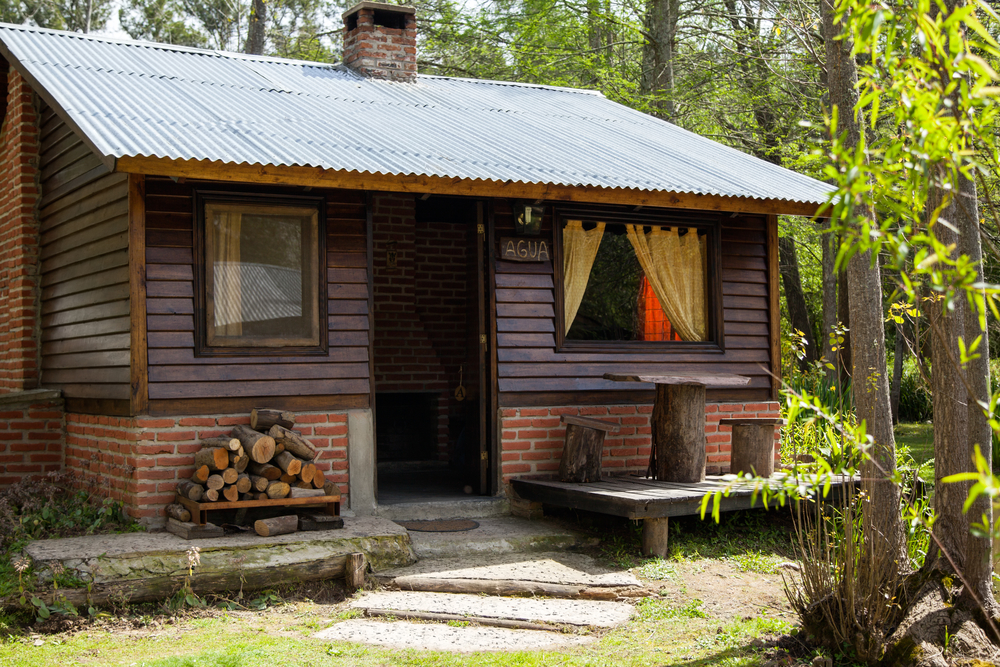There are a number of roofing choices available to complete your custom log home and make it look stunning. Besides the aesthetics, obviously you want your roof to be durable, long lasting and also within your budget range. And it can be anything from simple roofing to a unique customized style. The final decision comes down to the style of your log home and location. The decision typically comes down to the style of your log home, location and budget. Consult your log home builder or general contractor before you make a choice because it will affect your log home living. Do it right the first time around to avoid any nasty surprises in the future like a leaky roof.
1. Metal Roofing
Metal roofing systems (steel, aluminum, zinc, copper, and an assortment of alloys) are an extremely popular option for its contemporary and modern look. Metal roofing is available as shakes, shingles, tiles or vertical panels and is extremely durable as it doesn’t burn, rot, warp or split (warranted for 50 years at least). Metal roof comes in a variety of colors and textures. Metal roofs require very little maintenance and sheds rain and snow easily. You can also cut costs using screw-down, V-rib panels instead of standing seam roofing. Metal panels can be installed quickly, saving you labor costs too. Metal roofs are resistant to fire damage so you can get a break on insurance costs in many fire-risk areas by installing one on your log home.
2. Fiberglass and Asphalt Shingles
Fiberglass and Asphalt Shingles are the most economical and standard roofing material today in the United States. They come in dozens of color selections and several textures for dramatic appeal, with warranties that last from 15 to 30 years. An upgrade for asphalt shingles would be the architectural shingle, which is two times thicker, casts shadow lines and can mimic the look of slate, tile or cedar shakes.
It is better to opt for the higher end shingles, something with three dimensions that will add texture to the design. Asphalt shingles can be either organic (“Class C” rating) or inorganic (“Class A” rating- can withstand severe fire exposure). Organic shingles, made from wood pulp perform better in extreme climates than the inorganic ones. They are designed for easy maintenance and repair. But if you notice granules of sand in your gutters or bald patches starting on your cabin roof, then you need to consider re-roofing.
Asphalt and fiberglass shingles have a shorter lifespan due to the high heat generated by an inadequately ventilated roof. So be sure to add sufficient soffit and ridge vents as continuous air-flow paths to allow heat to escape.
3. Wood Shingles and Shakes
Wood roofing made of renewable resources are the classic choice for rustic log homes and can last over 50 years when installed properly. Wood shingles and shakes make up 2% of the market. The difference between shingles and shakes are that the former are sawn on both sides and are more even, whereas a shake is split on one or both sides and is chunkier. Cypress, cedar and Eastern white and Southern yellow pine are the most common species used. Some wood shakes arrive pretreated with preservatives from the factory; but others have to be periodically treated with an oil preservative at your site. Wood roofing weathers to a natural color, which adds to the rustic charm of your log home. Wood shingles and shakes expand and contract slightly with temperature and humidity changes so it is important to leave a slight gap between each during installation or else they can cup or buckle during expansion.
4. Structural Insulated Panels (SIPs)
These are rigid panels with a foam core of insulation that is bonded to a stiff outer skin, which creates structural strength. They are more efficient with superior thermal performance, protect from the weather, and are modular building components that can be quickly erected, which saves costly labor.
Structural insulated panels are made of rigid foam (generally EPS- expanded polystyrene) that is laminated to an oriented strand board for structural strength. These panels have highly efficient and super thermal performance and do not require any closed systems- venting so no insulation benefit is ever lost. Nor are there any spaces to trap moisture when the air cools. Therefore you get superior protection from the weather. The modular building components can be quickly set up, which saves costly labor. The panels are much stronger and offer better noise reduction quality than other roof construction methods.
No matter which material you choose for your log cabin roofing, it is always advisable to make your log cabin roof overhangs larger to keep your exterior logs protected. Getting your log cabin roof right gives you a greater sense of protection and security and reduces maintenance costs over the years. Performance Log Homes can help you make the correct choice you make for your cabin roofing according to your budget and aesthetic vision for your log home.


